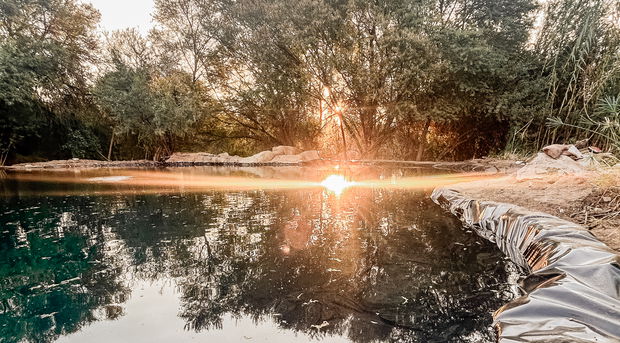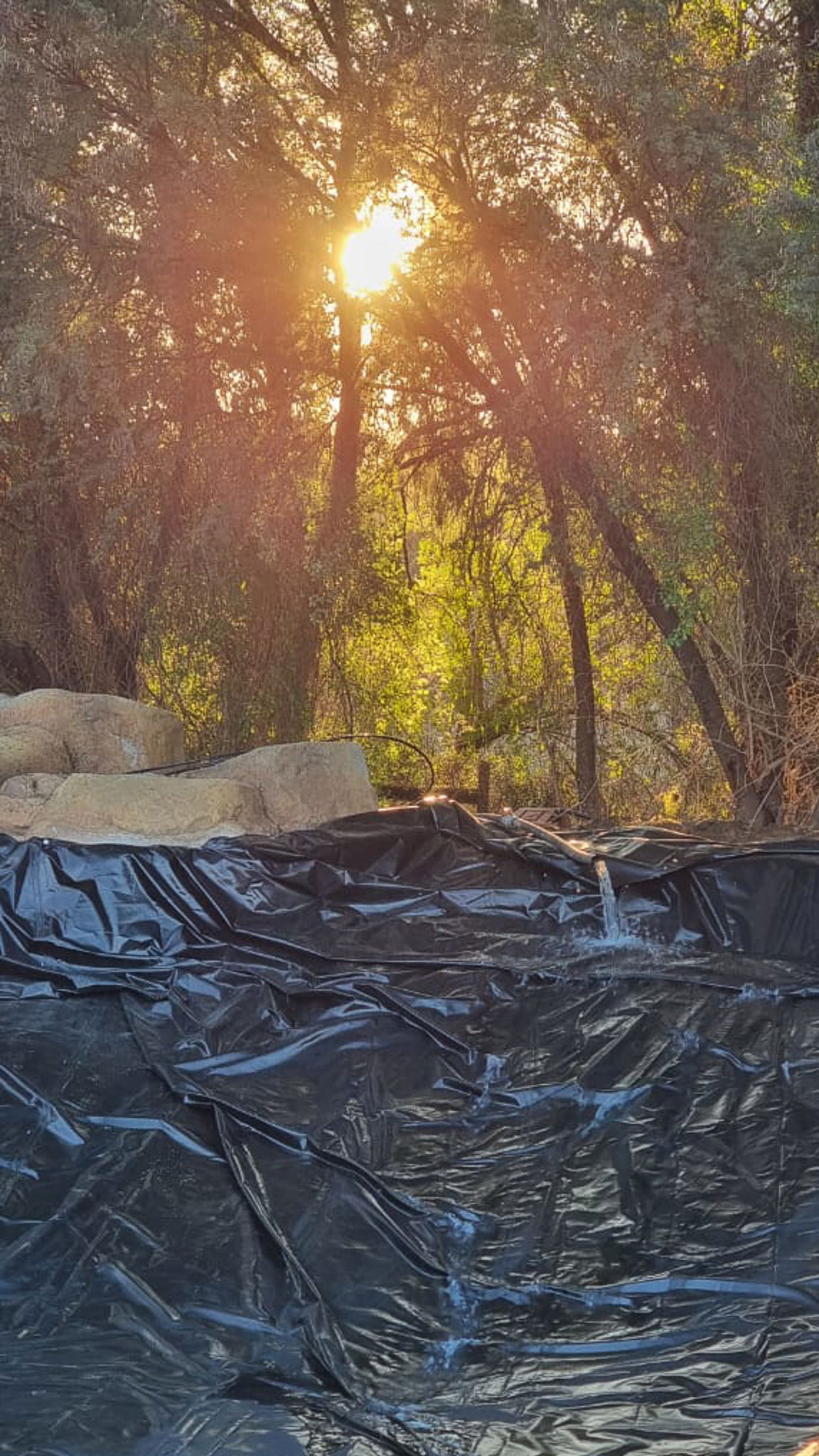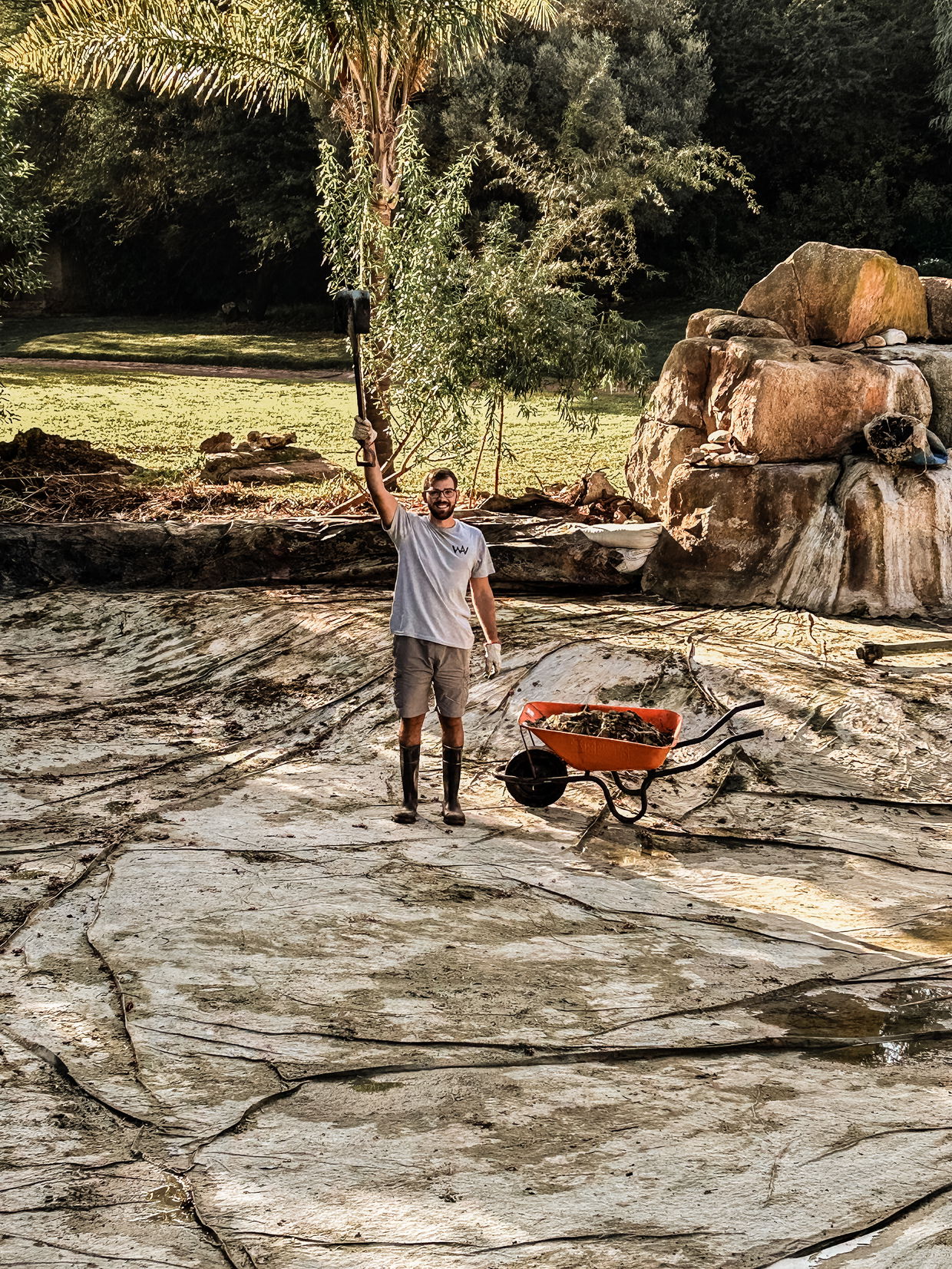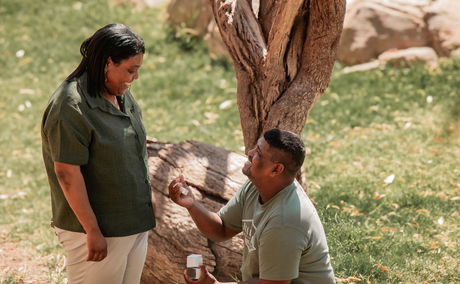Two travellers and their rescue dogs arrived in a truck the size of a tiny home. A day later, they were in our kitchens, spending time with our animals and sharing an unforgettable eye to eye moment with Jason the Nile Crocodile. Meet Susi and Kim. For most of their adult lives, their story looked familiar. Susi ran a large veterinary practice. She managed a team, handled emergencies and often slept four...
Unveiling our New Artificial Wetlands Bio-Filter

At Cango Wildlife Ranch, innovation and conservation go hand in hand. Today, we’re thrilled to announce the completion of our brand-new artificial wetlands bio-filter—a project that not only reduces our reliance on municipal and borehole sources but also exemplifies our commitment to sustainable water management. Join us as we dive into how this wetland functions, the tangible benefits it provides, and the broader sustainability goals it helps us achieve.
A Fresh Take on Water Reuse
Water is the lifeblood of any wildlife facility, and here in the Klein Karoo, every drop counts. For years, we relied heavily on municipal supplies and boreholes to meet our daily needs—until now. Our newly installed bio-filter captures and purifies roughly 24 000 litres of “backwash” (waste) water each day, converting what was once discharge into a valuable, reusable resource.
Collection and Pretreatment: Every time our habitat pools, fountains, and filtration systems backwash, that water—laden with sediments, organics, and dissolved impurities—flows into the main Zindagos (our volunteer lodge) dam. Here, gravity assists: heavier particulates settle to the bottom, allowing relatively clearer water to be extracted.

Pumping to the Wetland: From mid-depth in Zindagos, the partially treated water is pumped into the base of our new artificial wetland. This deliberate design ensures even distribution, preventing channelisation and maximising filtration contact time.
Natural Filtration at Work: As water moves upward through a carefully engineered stone bed, suspended solids are physically trapped between interlocking stones. Meanwhile, the root systems of native wetland plants—think Karoo reeds, sedges, and a few carefully selected indigenous blooms—absorb nutrients (nitrates, phosphates) and foster microbial colonies that break down organic contaminants.
When the stone bed reaches capacity, excess water gracefully overflows from the wetland’s top, cascading into a small channel that feeds our secondary dam. Voilà: that once-waste water is now clean, ready for reuse in irrigation, animal care, enclosure cleaning, and more.

USE CASE AND RANCH-WIDE IMPACT
1. Dramatic Reduction in Freshwater Demand
By recycling 24 000L of water daily, we’ve slashed our municipal and borehole withdrawals by nearly 35%! For perspective, that’s roughly the equivalent of 480 full bathtubs saved every day. Over a year, this equates to 288 000L per year, no longer tapped from external sources—allowing us to divert precious groundwater towards maintaining neighbouring ecosystems and responsible local use.
2. Cost Savings and Operational Efficiency
Less reliance on external water sources translates to lower utility bills and decreased energy consumption (fewer pumps on boreholes). Over time, these savings will be reinvested into other conservation initiatives—think expanded habitat restoration or new enrichment structures for our resident animals.
3. Biodiversity Boost
The wetland isn’t just a filtration system; it’s a new habitat. Insects, frogs, and even small birds are already making use of the tranquil pools and reed beds. By creating a semi-natural wetland environment, we’ve added another layer to our biodiversity offerings—study opportunities for visiting researchers, guided tours for school groups, and a serene spot for birdwatchers.
4. Educational Demonstration Site
One of our core values at Cango Wildlife Ranch is “learning through doing.” Our volunteers, local schools, tertiary institutions, and community groups will be invited to see firsthand how constructed wetlands emulate natural processes to purify water. Expect educational signage soon—highlighting each filtration stage, the importance of native plants, and the microbial partnerships that do much of the hard work underground.
 SUSTAINABILITY GOALS ADDRESSED
SUSTAINABILITY GOALS ADDRESSED
Clean Water and Sanitation (UN SDG 6)
Our bio-filter directly supports Goal 6 by ensuring water is reused responsibly and made available for wildlife care, landscaping, and community outreach. By treating water on-site, we minimize contamination of adjacent water bodies and reduce demand on municipal systems.
Responsible Consumption and Production (UN SDG 12)
Turning waste into resource showcases a circular-economy approach: less waste, more reuse. The project dovetails with our broader waste-management strategy—wherever possible, we treat, recycle, and repurpose rather than discard.
Life on Land (UN SDG 15)
By promoting wetland habitat creation, we encourage biodiversity and support local fauna. The roots, stones, and slow flows create microhabitats for aquatic insects, amphibians, and small birds—contributing to the health of our larger ecosystem.
Climate Action (UN SDG 13)
Conserving water and reducing energy needs for pumping borehole water translates into a smaller carbon footprint. Moreover, wetlands act as carbon sinks—plants sequester carbon into biomass and sediment. Over time, this habitat will help offset greenhouse gas emissions in a modest but meaningful way.
🌱 Did You Know?
Did you know that an adult reed plant can remove up to 60 percent of certain pollutants from water within just a few weeks? We’ve planted individual hydrophytes in our wetland—meaning they’re quietly working around the clock, sipping and sequestering contaminants while providing a splash of green across our landscape.
Meet the Team Behind the Magic
 This entire project would not have been possible without the tireless efforts of our in-house sustainability team. They mapped the landscape, calculated flow rates, designed the stone-bed gradient, sourced indigenous plants, and—most importantly—supervised every step of construction to ensure our bio-filter would perform as promised.
This entire project would not have been possible without the tireless efforts of our in-house sustainability team. They mapped the landscape, calculated flow rates, designed the stone-bed gradient, sourced indigenous plants, and—most importantly—supervised every step of construction to ensure our bio-filter would perform as promised.
Leoco Damme - For the expertly installed dam lining and an astonishing turnaround time, ensuring our primary impoundment was watertight from day one. Your craftsmanship allowed us to move swiftly from concept to completion.
Klein Karoo Seed Production - For generously supporting this project and allowing us to bring this to fruition!
Our Cango Sustainability Team: For dreaming up this project, weathering on-site challenges, and celebrating every milestone—whether it was hauling tons of stone or transplanting our first reed. Your dedication embodies the spirit of innovation we cherish at Cango.
What’s Next?
Over the coming months, we’ll be monitoring water quality parameters—pH, turbidity, nutrient levels—to fine-tune plant densities and stone configurations.
As the wetland matures, we expect to spot more wildlife. We’ll document progress with periodic video updates on our newsletter and social channels, so stay tuned.
Our new artificial wetlands bio-filter embodies Cango Wildlife Ranch’s unwavering commitment to sustainable innovation. By transforming waste water into a fresh, on-site resource, we’re not only reducing costs and conserving precious water but also creating habitats, supporting education, and aligning with global sustainability goals.
With heartfelt gratitude to Leoco Damme, Klein Karoo Seed Production, and our own dedicated sustainability team, we look forward to the positive ripple effects—both ecological and educational—that this project will continue to generate!
Further Reading
Jade and Levinia met in the most unexpected way. Both attended the same church - he played the organ, and she was trying to leave early, and found her car blocked in by his. While he played, she waited. When she finally drove off, neither imagined that moment would change their lives.
Wild Animal Volunteers arrive with purpose. Their days begin with structure and intention as they join the team for morning duties. They help prepare specialised diets, assist with habitat care, support Animal Caregivers, and take part in the routines that keep our facility running smoothly. Every task is practical. Every action matters. Each moment contributes directly to animal welfare.
















Share This Post